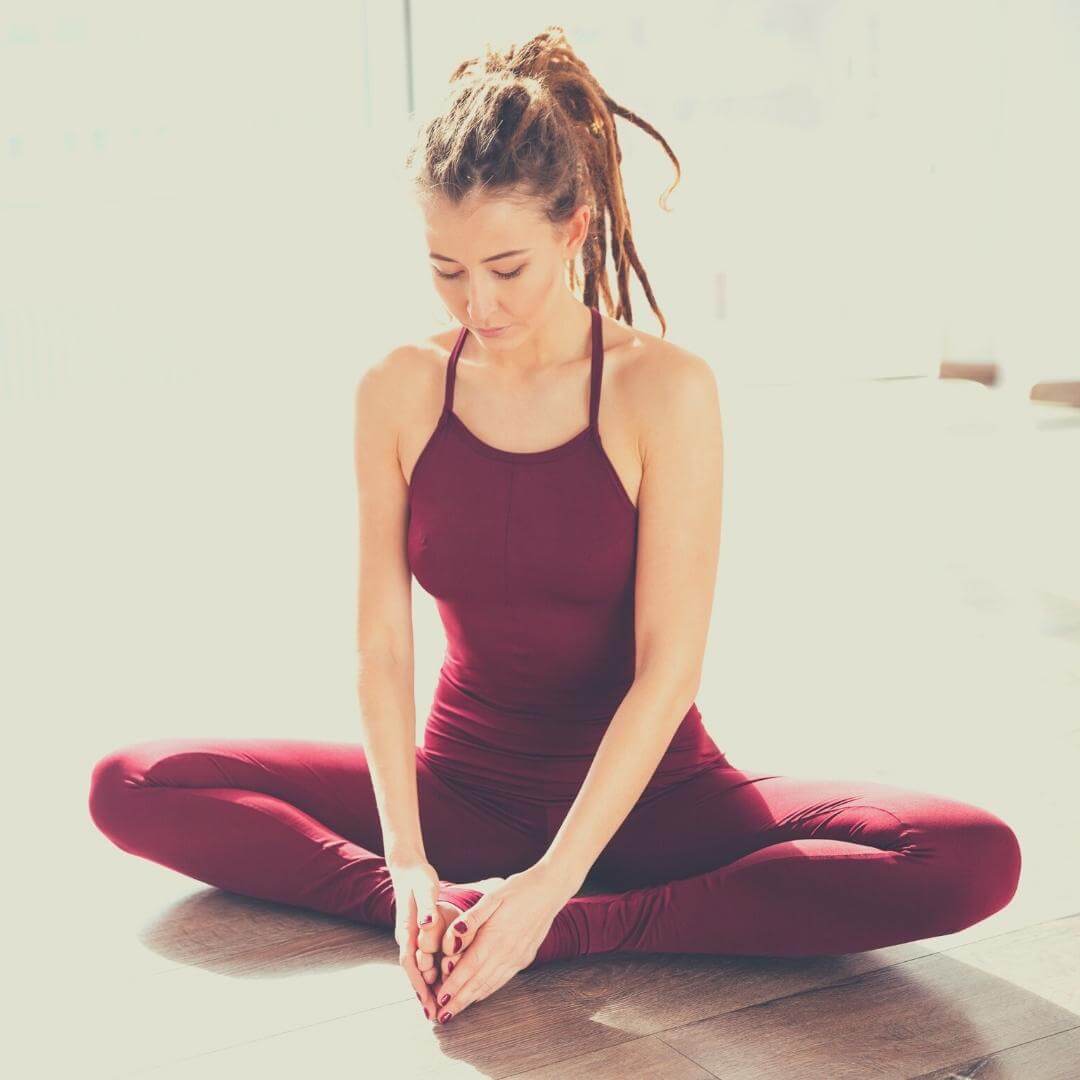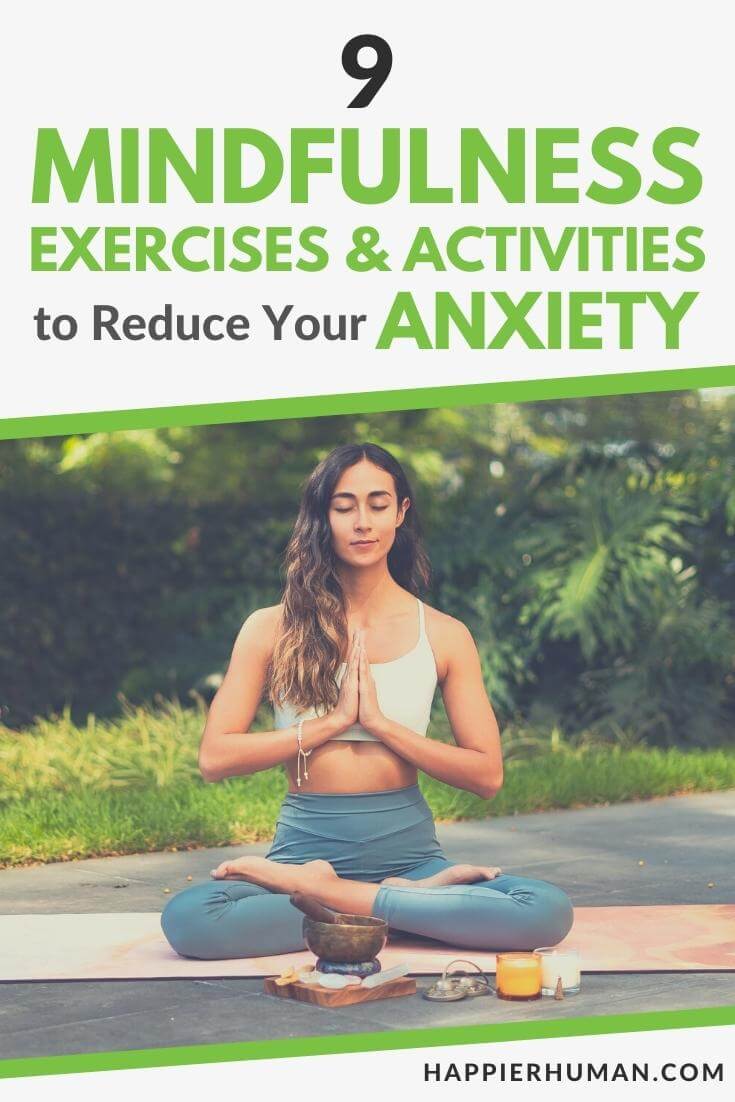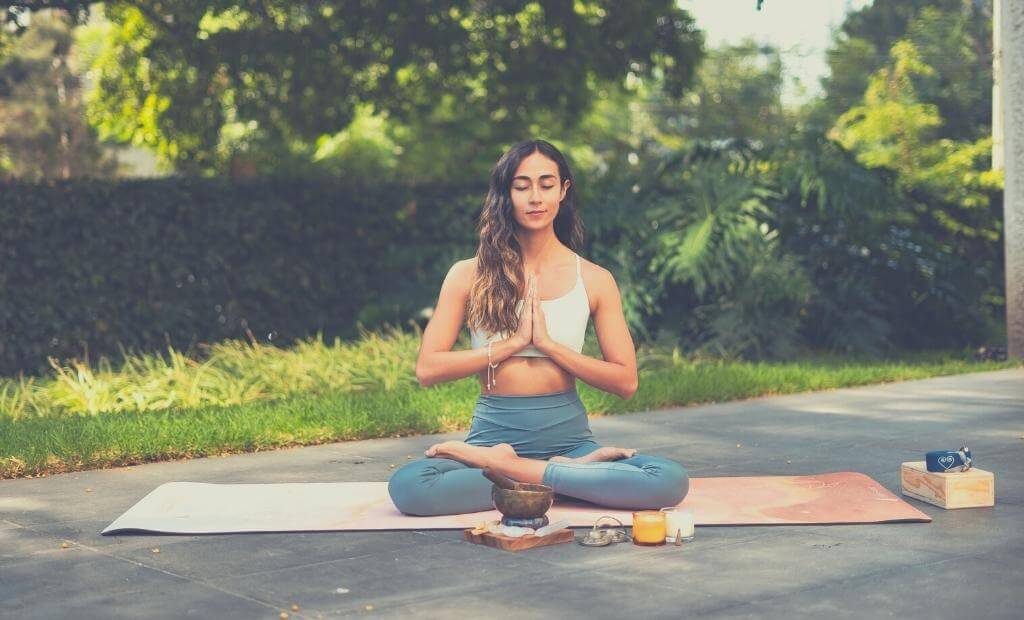Sometimes anxiety can feel like an untamable monster that won’t go away. And yet, you have the power to conquer that frightful beast with the right weapon. There are multiple ways to combat anxiety… such as exercise, lifestyle changes, or diet.
Today, however, we are going to talk about one of the mightier weapons: mindfulness. It is perhaps the most simplistic way to combat anxiety, as it requires little time and can be done sitting outside or lying in bed.
Really, it can be done almost anywhere, which is why our goal is to give you tools you need to fight your monster and live a happier life.
What is Mindfulness?
Mindfulness is the ability to reach inner peace and understanding about oneself. Typically, it focuses on controlling thoughts, awareness of the present moment, and accepting emotions. Anxiety accomplishes the complete opposite.
Anxiety encourages racing thoughts, stresses the future, and ignores your feelings. Mindfulness helps ground our senses and fight anxiety. Engaging in mindfulness practices gives you the tools necessary to fight the power anxiety holds over you.
It's vital to understand that stress and anxiety have lasting effects on the body. Chronic stress can cause heart disease, high blood pressure, headaches, and muscle tension. Anxiety also leads to other mental illnesses, such as panic disorders, mood disorders, and depression.
Fortunately, there are medical interventions that help reduce stress. Doctors recommend medication to help reduce the symptoms.
However, although medication helps many people in need, doctors also suggest other treatments alongside medication. Research shows that psychotherapy is more effective in fighting anxiety than medication intervention.
And since mindfulness is a type of psychotherapy, mindfulness exercises actively prevents anxiety symptoms and keeps them away.
What are Mindfulness Exercises?
There are various exercises and techniques to help you reach mindfulness. The practices vary depending on what you prefer and the goals you’d like to accomplish.
For instance, if you want to improve your concentration, you’d benefit from breathing exercises. Breathing exercises require you to find a quiet place, sit somewhere comfortable, and focus on breathing.
After a short time, thoughts will enter your mind, such as “what will I have for dinner today?” The goal is to ignore those thoughts and concentrate on breathing, freeing your mind from unnecessary worries.

Still, that is easier said than done. That’s why it’s important to practice mindfulness and make it an active part of your life. The good news is that the more you practice, the easier it will be to reach inner peace.
Mindfulness exercises vary, and not all techniques will work for you. You must find the best exercises to help you reach your goals. And, if you suffer from anxiety, there are plenty of exercises that can help reduce stress and body tension.
So, try one of these mindfulness exercises for anxiety, stay dedicated, and you’ll soon notice the benefits mindfulness has to offer.
1. Appreciate the Small Things in Life
Don’t let anxiety ruin everything that should be enjoyable in life. Next time you engage in something you love – be sure to appreciate what you are doing, even if it is something small.
When eating your favorite dessert, take the time to acknowledge everything you enjoy about it. Don’t allow yourself to experience the negative thoughts that might pop into your head while eating.
For example, do you sometimes think, “I’m going to gain so much weight,” or “I’m wasting money buying dessert?” That’s the anxiety talking. You deserve to enjoy what you love, without the guilt anxiety brings you. That’s why it’s essential to enjoy the small things in life.
Even the most minor pleasures deserve to be acknowledged. Think about specific moments you can’t wait to experience during the day and recognize when they happen. Personally, when the Fall season approaches, I take a moment to breathe in the crisp smell of autumn and let myself enjoy the beauty of nature.
So, next time you feel stressed or anxious, pick something that brings you joy, and let yourself feel happy as you engage in your favorite activity.
2. Stop Catastrophic Thinking
Anxiety has a way of making you believe catastrophic occurrences are going to happen. Sure, who doesn’t think about a plane crash before you board a flight? With most people, that thought will enter their minds and slowly drift away.
Unfortunately, people suffering from anxiety won’t let that thought go away. Instead, they think about the plane crashing for the entire flight!
Anxiety forces you to think about the worst-case scenario and makes you believe it will happen. It’s helpful for you to realize that the worst-case scenario is also the least likely scenario. It’s time to stop catastrophic thinking.
There is no reason to prepare for a horrible outcome because chances are – it’s not going to happen. However, anxiety still forces you to prepare for it. So, your body becomes tense, your thoughts race, and your heart beat faster because you are preparing for something that will never happen.
In the end, you are fine, but your body is tense from preparation for a catastrophe. So, how do you stop catastrophic thinking?
You can read our article 7 Ways to Stop Catastrophic Thinking & Catastrophizing to help you prevent catastrophic thoughts. But, below is a four-step exercise you can practice the next time you start catastrophizing a scenario.
- Recognize you are experiencing anxiety and catastrophic thinking.
- Focus on your breathing to help you get rid of your bad thought.
- Rationalize by explaining to yourself why your catastrophic thought is unlikely to happen.
- Try to focus on positive outcomes instead of negative ones.
3. Self-Acceptance Mantras
Are you someone who has trouble taking risks because you fear failure? Or maybe you have difficulty making friends because you believe people won’t find you interesting? People who suffer from anxiety tend to have negative thoughts about themselves.
Those negative thoughts turn into patterns of self-abuse. It’s time to stop thinking badly about yourself and begin to practice self-love.
Mantras are an excellent way to disturb negative thoughts about yourself and turn them into self-acceptance. Mantras are words or statements said during meditation to help improve self-worth. When anxiety continuously tells you that you are not worthy of self-love, you start to believe it.
So, it’s time to fight those negative thoughts about yourself with positive ones. When you continue to chant positive phrases about yourself, you’ll begin to believe you are worthy of self-acceptance and love.
Practicing mantras are fun and help raise your self-esteem. It’s also one of the most straightforward exercises you can practice. You can recite your mantras whenever you like, but many chant mantras during a period of meditation.
During meditation, you will say a phrase that you would like to tell yourself, such as, “I am confident,” and then you’ll continue to chant your mantra as you meditate silently. Chanting mantras help you become present and enables you to take in the words you are saying.
You deserve to be kind to yourself, don’t let anxiety ruin your self-worth, and soon you’ll notice a boost in your self-esteem.
4. Living in the Moment
Sure, it might sound like a cliché but living in the moment is one of the best ways to reduce anxiety. Anxiety encourages racing thoughts and constantly makes you look ahead into the future. If you continuously think about what is to come next, you will never enjoy what you have at the moment.
Say you are planning to give a speech at a work event. Sounds dreadful, right? But, you are doing everything you can to prepare for the speech. You research, ask for advice, and when the big day comes, you do such a great job that your boss and colleagues are impressed.
However, you appear to have trouble listening to their praises because all you can think about is how much work you will have to do when you return to the office. You are too busy thinking about the next project when you should be happy at the moment.

Anxiety makes you believe that you must always prepare for the future. Remember to live within the moment. If there is something you are looking forward to, let yourself enjoy the moment when it comes.
One way to accomplish this is to prevent thinking in ‘future tense.’ Don’t let your mind think about the future. One way to achieve this is to ground yourself. Grounding yourself begins with focusing on something in the environment, such as a chair or picture frame.
Then, allow yourself to hear what is happening around you, focus on mumbled voices or the sound of a fan. Soon, you’ll feel present in the moment, and you can live within it.
5. One-Minute Meditation
Meditation has been practiced for centuries to free the mind and body from worldly stresses. Meditation is encouraged by psychiatrists because it’s been proven to work for those who suffer from extreme stress and anxiety. Many people can meditate for an hour or more to reach a state of inner peace.
Unfortunately, if you are someone who does not have the luxury of spending an hour on meditation, you are not alone. The good news is that you do not have to spend long hours to reach a state of inner peace. Instead, you can meditate throughout the day in one-minute intervals.
The whole point of meditation is to stop your actions and focus on yourself. It can increase concentration and keep you grounded. Try one-minute meditations when your body begins to tense, or your heart starts to pump a little faster. Listen to your body and understand when it needs a small break.
Close your eyes and listen to the world around you, chant a mantra, focus on your breathing, and clear your mind. You’ll begin to feel relief as you allow your body to destress.
One-minute meditations can be done anywhere and at any time. So, take advantage of the power of meditation, even if it's just for a minute.
6. Log Off
We live in an exciting time where we can access the world around us at any moment. We can chat with friends, watch videos, and catch up on recent events. Computer technology is one of the greatest inventions of all time. But, like with most things, too much electronics can make you lose sight of who you are.
Are you someone who must always have their phone on them? Does your stomach drop when you get an email notification from your work? How often are you reading about tragedies in the world today? The number of notifications and information we access can feel overwhelming, increasing anxiety.
Be sure to practice logging off when battling anxiety. That can be easier said than done. Putting it down for even a few minutes is difficult when you are attached to your phone.
Logging off requires you to turn your phone off and set it aside for at least 30 minutes. That may sound stressful initially, but dedicated practice is key to this exercise.
Soon, you won’t feel so dependent on your phone and can free yourself from feeling anxious whenever a notification sounds. If you need help finding activities to do while logging off, check out our list of fun things and activities to do when you’re bored at home.
7. What Would You Tell A Friend?
Anxiety disorders have a way of making your thoughts spiral into a snowball of stress. The ideas start small, and then grow bigger and bigger until you become so tense that you cannot think straight. Here is an example of anxious thought patterns:
The thought process above is very typical of someone who suffers from anxiety. If you relate to this anxious snowball, you may benefit from the “What would you tell a friend” exercise.
When you begin to have racing thoughts about yourself, stop, and pretend like a good friend just told you everything you were thinking. What would you tell them? You might tell your friend they are overthinking the situation and should just have fun.
This exercise is great because it pulls you away from yourself and forces you to look at the bigger picture. Getting another perspective on the situation can help you realize how dramatic your anxiety can get.
Also, you are receiving advice from yourself, which helps prevent you from snowballing further. Remember to treat yourself like a good friend because you deserve to treat yourself with kindness.
8. Release Your Thoughts
We’ve discussed ways to stop racing thoughts and engage with positive thinking. But, sometimes, anxious thoughts refuse to go away. They always pop right back into your head, no matter how hard you try to combat them. So, if negative thoughts constantly occupy your mind, it’s time to kick them out.
Journaling is an excellent technique to get rid of thoughts that aren’t worthy of being inside your head. If you’re feeling anxious, pick up a pen and paper and begin writing down your emotions. Be honest with yourself as you write. Let your worries, stress, and thoughts flow on the paper. It doesn’t even need to make sense.
However, if you find writing down your thoughts challenging, prompts are an excellent way to get you to write freely. Our prompts for anxiety can help you free your mind of worry and stress.

Journaling is a way to release negative thoughts and energy from your body. Imagine your anxious thoughts are hiding away in your mind. They are constantly picking at you and making you feel too stressed to even function. They interrupt happy moments, and the thoughts refuse to let you think about anything else.
Well, it’s time to reach into your mind, write those anxious thoughts down, and let them disappear from existence. In the end, you will feel lighter and more mindful.
9. Create Your Own Ritual
It’s been repeated that anxiety stems from racing thoughts, catastrophic thoughts, and constantly thinking about future events. It’s fair to point out that most of these exercises encourage you to practice them sometime in the future.
This is pretty ironic because if you tell someone with anxiety that they must set time aside to combat anxiety, chances are, it will make them more anxious.
So, if you find it stressful to set time aside to practice these exercises, you may benefit from creating your own ritual. Meaning you can practice mindfulness throughout certain parts of your day.
There are many techniques to reach mindfulness, such as breathing, slowing thoughts, and becoming present in the moment. You can decide when and where you practice mindfulness.
Start your own traditions and rules to feel comfortable and control your mindfulness exercises. Here are a few examples of the types of traditions you can start on your own:
Final Thoughts on Mindfulness Exercises
These mindfulness exercises for anxiety each share a common goal: to help lower your symptoms of stress. Whichever one or ones you choose, you’ll notice yourself feeling calmer and more at peace. Eventually, you’ll be happier. Soon, you will defeat that beast of anxiety with mindfulness as a weapon!
It’s essential to stay on top of your exercises so you can experience all the advantages mindfulness can offer. If you’re curious about the added benefits you get from practicing mindfulness, you can read our article 11 Mental & Health Benefits of Practicing Mindfulness.
Reduce your anxiety and be more mindful with the following posts:
- 11 Mindfulness Activities to Try at Work
- 6 Authentic Ways to Deal with Social Anxiety in ANY Situation
- 20 Grounding Techniques to Reduce Your Anxiety and Cope With PTSD
- 51 “Thinking of You” Quotes to Let Someone Know You Care
Finally, if you want a simple way to reduce your stress and anxiety, then try writing these 35 mindfulness journaling prompts to live more in the present moment.


